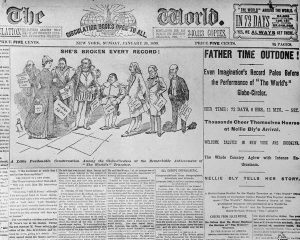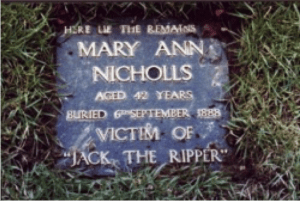“Ugh, it’s Monday” are the words that usually follow the arrival of the most dreaded day of the week. The sighs floating in the air are palpable and nothing seems possible. Mondays always carry with them a negative connotation and contain components such as depression, fatigue, and anguish. But to a San Diego elementary school, and to a troubled sixteen year old, Monday, January 29, 1979 held an even more distressing meaning.

Students at Grover Cleveland Elementary School, located in San Diego, California, began what they believed would be a normal Monday morning like any other, with bells ringing and students racing to their classes. Little did they know, however, that across the street, sixteen-year-old Brenda Ann Spencer was aiming her .22 caliber semiautomatic rifle right at society’s ultimate refuge, the elementary school, and its surroundings. After the first bell rang, Brenda broke the panels on the front door of her home, which was located right across the street from the elementary school. And she began to fire. The school’s principal, Burton Wragg, while rushing outside, was hit on the shoulder and chest with Spencer’s bullets and eventually died. Michael Suchar, the school’s custodian, ran outside with a blanket in order to cover Wragg and keep him from going into shock, but he quickly became the second victim of Spencer’s shooting and lost his life. In between all the chaos, 28 year old Robert Robb, a recent graduate of the police academy, while examining Wragg’s and Suchar’s bodies, was shot under his right shoulder blade.1 He would go on to survive though, along with the eight other children who were wounded in the incident. At least three of those children had abdominal wounds. A nine-year-old student, Cam Miller, was struck in the back with a bullet that exited through his chest without hitting any internal organs. Another, Christy Buell, was shot through her abdomen and in the buttocks, and had to undergo surgery in order to repair her intestine.2
When Gus Stevens, a reporter for the San Diego Evening Tribune, began calling around the area to gain more information about the shooting, he coincidentally placed a call to Spencer’s home where she gave him exactly what he wanted. She described the shooter, a sixteen year old, and the shooter’s address. When Stevens realized that she gave him her own address, he recognized what was going on and requested an interview while another staff member informed the police of the situation. The police, now aware of where the shots were coming from, were able evacuate the children and obstruct Spencer’s line of sight while trying to negotiate with her. After several hours, Brenda Spencer surrendered her weapon and several rounds of ammunition, and was subsequently arrested. While on the phone with Stevens, Spencer had stated that she was just shooting for the “fun of it.” She went on to say that she just didn’t like Mondays and did this “because it’s a way to cheer up the day.”3

Contrary to her initial claim, she later went on to state in her 2001 parole hearing that she had been “sexually abused by [her] father” and was “waiting for the cops to show up so they could shoot [her].”4 This new information has fueled many more theories today about Brenda Spencer’s true motives in committing such a crime. During her pretrial psychological testing, an injury to Spencer’s temporal lobe came to light. Spencer has also stated in a letter from prison that she experiences “grand mal seizures” that she has to counteract with medications.5 Such a brain injury would definitely be a precursor to epilepsy, which is two to four times more common among violent offenders than the public.6 The lack of treatment she received for this disease, to some, proves the neglect that she experienced from her family and in her childhood. Psychologist Jonathan Fast introduces the idea that her brain injury, abuse, and the effects of it pushed her to her final actions. He believes that the shame, ridicule, inferiority, and powerlessness that she felt encouraged her to go as far as she did. In another letter she wrote in prison, she stated that her “father had done everything a person could do to another person. The beatings, the touching, the emotional abuse.” She went on to state that no one, not teachers or counselors, gave her assistance through this, so she simply thought that this was how the world and how life worked. When her father gifted her the .22 caliber rifle, she thought that he was finally telling her to do it: to take her life successfully, unlike her past suicide attempts, and leave the world forever.7
Whether these theories are true or not, Brenda Spencer was tried as an adult and pleaded guilty to two counts of murder and nine counts of assault. She was sentenced to twenty-five years to life in prison, and is still serving her sentence at the California Institute for Women. The shooting has inspired a song by the Boomtown Rats called “I Don’t Like Mondays,” and has also gained other media coverage through a documentary.8 Her action went down in history as the first high profile school shooting and has become a vanguard to many future, unimaginable school situations and violent outbreaks. Whether Spencer was a cold-hearted killer or a truly lost and confused soul that simply wanted an escape, it is undeniable that her horrible actions have had some frightening consequences in our modern world.
- Jonathan Fast, Ceremonial Violence (New York: The Overlook Press, 2008), 25, 70-71. ↵
- Tamara Jones, “Look Back in Sorrow,” Good Housekeeping 227, no.5 (November 1998): 118. ↵
- Jonathan Fast, “Unforgiven and Alone: Brenda Spencer and Secret Shame,” in School Shootings: International Research, Case Studies, And Concepts For Prevention, ed. Nils Böckler (New York: Springer, 2013), 253-255. ↵
- Debra Sevey, “Subsequent Parole Consideration Hearing of Brenda Spencer,” (Capitol Electronic Reporting, 2001), 15-16. ↵
- Jennifer Furio, Letters From Prison: Voices Of Women Murderers (New York: Algora Pub., 2001), 134. ↵
- Jonathan Fast, ” Unforgiven and Alone: Brenda Spencer and Secret Shame,” in School Shootings: International Research, Case Studies, And Concepts For Prevention, ed. Nils Böckler (New York: Springer, 2013), 251. ↵
- Jennifer Furio, Letters From Prison: Voices Of Women Murderers (New York: Algora Pub., 2001), 134-135. ↵
- Encyclopedia of School Crime and Violence, September 2011, s.v. “Brenda Spencer,” by Laura L. Finley. ↵



243 comments
Belene Cuellar
I’m not sure whether I should be disgusted by this girl or empathetic towards her. I can’t believe she was pushed to the point where she ended up shooting so many innocent people. I hope she got the help she needs now that she is away from those that hurt her. Overall this was a very interesting article that offered a different perspective on the criminal. It shows that not every criminal is a cold blooded killer, but a troubled person who was pushed too far in her life.
Josselyn Arrieta-Meraz
This article took me by surprise starting from the title. I thought, what do Monday’s have to do with a shooter in an Elementary school? Little would I have thought that in fact the shooter suffered of problems and abuse as child by her father. To me this made sense, but to think on what she did and how much abuse can affect you physiological state to the point where you think about hurting others and your self. This catastrophe serves as an example of the many problems that surround or world in this case not only were the victims the victims but the shooter herself but from something else.
Abigale Carney
Very interesting article! The details you provided, including the images that you chose kept me engaged throughout the entire article. I liked how you discussed the issues Spencer dealt with as a child and how it influenced these psychotic acts. School shootings are sickening to me, and I do not understand the satisfaction of endangering the lives of children. Only a true psychopath would commit these crimes towards children because they simply “hate Mondays”.
Amanda Cantu
Great article but what a horrible incident. I get it that everyone hates Mondays but for someone to do something like that is completely insane. If she truly wanted to do something to cheer herself up she could go play with a dog instead killing innocent people. No one deserves to go through that especially children because those kids will remember this forever. I understand that if you have physical and emotional experiences that it makes you do crazy things but there are people to go to for help if you really want it. I feel so sorry for her if her father did all those things to her and she didn’t deserve it but to put those kids through that kind of trauma isn’t going to fix things for her. It’s sad that people have to go through extreme measures just to have people listen to what they need.
Alexis Renteria
This was a very interesting and well written article. I really liked how you not only describe the details of the events but also bring attention to the psychological problems Brenda Spencer faced as a child and how it influenced her motives. Events like these are so saddening but, I’m glad that they bring awareness
to tragic events that could happen anytime and anywhere, and make us think of possible ways to prevent these type of events.
Crystalrose Quintero
It was such a grabbing image to begin with before reading. To see such a young girl in cuffs really had me wanting to read to find out what happened. The first paragraph was so capturing by detailing what kind of mood comes form Mondays. It was so sad to see such tragedy at a school. But it was written with such detail that it felt like I I was there the moment it occured.
Jasmine Martinez
I had never heard of this, and I found it really interesting to read about. It’s such a horrible act of evil. It’s so sad to think of all the scared children and how they will always remember this day. Whether it was due to the years of abuse from her parents, or as stated that she did this just to have “fun”, is unbelievably sad. What kind of person can wake up and just want to do these kinds of things to another human being? It’s truly disgusting, and sad.
Justin Garcia
I believe this quote sums up the reality of the world “Some people just want to watch the world burn”. There are people that are capable of monstrous acts and their reasoning is not more than I felt like it. The fact that someone this young could have the malicious intent to harm small children is truly sicking. This just shows that as people we need to be more wary of not only our surroundings but the people around us. The article however, was very informative. The article did well to inform me of a subject I knew nothing about.
Valeria Hernandez
Evelin Joseph writes an interesting and captivating article. She captures my attention with her introduction. She introduces various theories that justify the shooter yet she stays objective. A brilliant move, because she is able to present a story arc that develops into an intriguing possible response to the tragedy however the event is still a mystery. She provides readers with a structure and interesting article.
Samuel Stallcup
I never knew about this, and I’m glad I read it because her “motive” is great, as in funny, rather I still feel this is quite a sad event. I also liked how you made the article more about the abuse this woman sustained during her preadolescence and during her teenage years. Often, people just write off and ignore anyone who has committed a heinous crime, and often it’s not really fair because, like this case, there is something deeper than just “I felt like doing it,” or “I hate Mondays.”